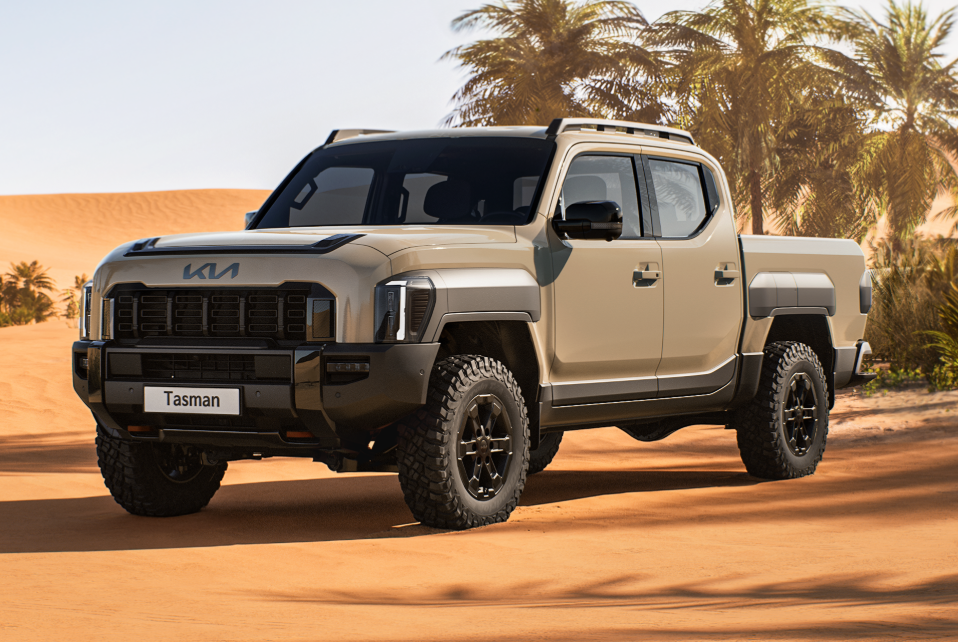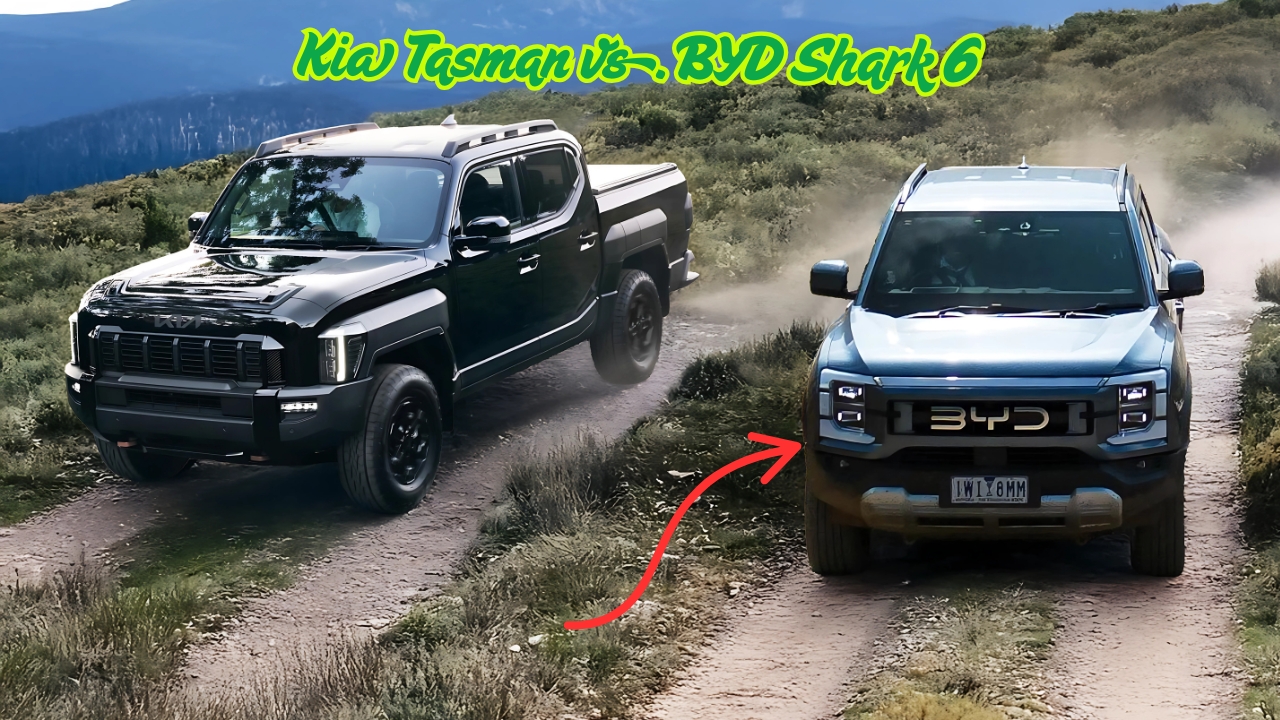Kia Tasman vs BYD Shark 6: The Australian ute market is experiencing its most revolutionary moment in decades. Two game-changing pickups have emerged to challenge the traditional diesel dominance: the Kia Tasman and the BYD Shark 6.
These aren’t just another pair of workhorses – they represent completely different philosophies on what the modern Australian ute should be. One brings Korean engineering excellence with proven diesel reliability, while the other delivers cutting-edge plug-in hybrid technology that’s redefining what efficiency means for tradies and weekend warriors alike.
Pricing Battle – Value That Makes Sense
The pricing strategies of these two utes couldn’t be more different, yet both aim for the sweet spot that Aussie buyers demand.
Kia Tasman pricing starts from $42,990 plus on-road costs for the entry-level S 4×2 model, with the range-topping X-Pro 4×4 reaching $74,990 plus on-roads. This aggressive pricing strategy positions the Tasman to undercut established players like the Ford Ranger by hundreds of dollars while offering similar capability.
The BYD Shark 6 takes a different approach with a single Premium variant priced at $57,900 before on-road costs. While this might seem like a premium price point, the Shark 6’s plug-in hybrid technology and extensive standard equipment make it competitive against mid-spec traditional utes.
Bang for Your Buck Analysis
When you break down the value proposition, both utes offer compelling reasons to consider them over established alternatives. The Tasman’s broad pricing range ensures there’s something for every budget, from the value-conscious tradie to the tech-savvy weekend explorer.
Powertrain Philosophy – Diesel vs Electric Revolution
The biggest difference between these two competitors lies under their bonnets, where completely different philosophies about the future of ute power come into play.
The Kia Tasman features a proven 2.2-litre turbocharged diesel engine producing 154kW of power and 440Nm of torque, paired with an 8-speed automatic transmission. This setup delivers a claimed 0-100km/h time of 10.4 seconds – respectable for a workhorse but not exactly thrilling.
The BYD Shark 6 completely flips the script with its plug-in hybrid architecture, combining a 1.5-litre turbocharged petrol engine with dual electric motors to produce a massive 321kW of combined power and 650Nm of torque. The result? A blistering 5.7-second sprint to 100km/h that leaves most sports cars in the dust.
Real-World Performance Implications
The Shark 6’s electric motor assistance means instant torque delivery that transforms how a ute feels both on-road and off. No more waiting for turbo lag when you need power for overtaking or climbing steep grades.
Meanwhile, the Tasman’s diesel reliability means proven durability and widespread service network support – crucial factors for commercial buyers who can’t afford downtime.
Towing and Load Capacity – Getting the Job Done

Every serious ute buyer in Australia asks the same question: “Can it tow my boat/caravan/trailer?” Both these newcomers deliver impressive answers, albeit with different approaches.
The Kia Tasman offers a solid 3,500kg braked towing capacity across all variants, with payloads exceeding 1,000kg standard. The ute’s tub measures 1512mm (length), 1572mm (width), and 540mm (height) with a 1173-litre cargo capacity that can fit a standard pallet between the wheel arches.
The BYD Shark 6 provides a 2,500kg braked towing capacity – lower than the Tasman but still adequate for most recreational needs. However, it compensates with 1200 litres of tub capacity and the unique advantage of vehicle-to-load (V2L) capability that can power tools and appliances directly from the ute.
The V2L Game Changer
The Shark 6’s V2L functionality is revolutionary for tradies. Imagine powering your angle grinder, lights, or even a coffee machine directly from your ute’s battery – no generator required. This silent, emission-free power source could transform how work sites operate.
Technology and Features – Modern Meets Practical
Both utes pack impressive technology, but their approaches reflect their different target markets and price philosophies.
The Kia Tasman includes an Integrated Panoramic Display featuring a 12.3-inch Digital Driver Cluster + 5-inch HVAC + 12.3-inch Multimedia Screen. Higher trim levels add Highway Driving Assist, blind-spot cameras, and surround-view cameras for safer maneuvering in tight spaces.
The BYD Shark 6 counters with a massive 15.6-inch rotatable touchscreen, 360-degree camera system, wireless phone charging, and premium 8-speaker audio. The rotating screen is particularly clever – landscape for driving, portrait for apps and navigation.
Safety First Approach
The BYD Shark 6 already carries a five-star ANCAP safety rating based on 2025 testing. The Kia Tasman is expected to undergo ANCAP testing by mid-2025, with Kia confident of achieving five stars given the comprehensive safety suite.
Off-Road Capability – Adventure Ready
Australian utes need to handle everything from suburban streets to remote mining sites, and both these newcomers bring serious off-road credentials.
The Kia Tasman X-Pro variant features 28mm higher ride height (252mm total), all-terrain tyres, electronic rear differential lock, low-speed off-road cruise control, and rock mode with transparent bonnet camera system. All 4×4 variants come standard with mechanical rear diff lock – no extra cost.
The BYD Shark 6 offers double-wishbone front and rear suspension with Mud, Sand and Snow terrain modes. Advanced features include Hill Hold Control, Vehicle Dynamic Control, Hill Descent Control, and Auto-Hold for confident off-road navigation.
Suspension Sophistication
The Shark 6’s independent rear suspension is unusual in the ute segment and provides superior ride quality on rough surfaces compared to traditional leaf-spring setups. However, the Tasman’s more conventional approach might appeal to buyers who prioritize proven durability over comfort.
Efficiency and Range – Running Costs That Matter
Fuel efficiency is becoming increasingly important as fuel prices climb and environmental consciousness grows among Australian buyers.
The Kia Tasman achieves 7.58L/100km on the combined cycle with its diesel engine – respectable but not exceptional in today’s market.
The BYD Shark 6 offers up to 100km of pure electric range from its 29.58kWh battery, with a combined total driving range of up to 800km. Official consumption figures show 7.9L/100km when the battery is depleted, but just 2.0L/100km when operating with battery assistance.
Real-World Cost Savings
For urban commuters, the Shark 6’s electric-only capability means potentially zero fuel costs for daily driving. Even when the petrol engine kicks in, the hybrid efficiency substantially reduces running costs compared to traditional diesel utes.
Availability and Market Reception
Timing is everything in the competitive Australian ute market, and these two vehicles are taking markedly different approaches to their launches.
Kia Tasman deliveries begin in July 2025, with dual-cab pick-up models arriving first, followed by dual-cab chassis in August and single-cab chassis in late 2025. Kia is targeting 20,000 annual sales – representing around 10% of total ute sales in Australia.
The BYD Shark 6 is already available, with orders opening in October 2024 and first customer deliveries beginning shortly after. BYD crashed its own website due to order volume, recording 2,000 orders in the first 24 hours. BYD has already shifted 6,129 Sharks so far this year, making it the brand’s best-selling vehicle.
Market Momentum
The Shark 6’s early availability gives it a significant head start in building market share and customer loyalty. By the time the Tasman launches, BYD will have real-world feedback and potentially refined their offering based on Australian conditions.
Which Ute Should You Choose?
The decision between these two revolutionary utes ultimately depends on your specific needs, values, and priorities.
Choose the Kia Tasman if you:
- Need maximum towing capacity (3,500kg)
- Prefer proven diesel reliability
- Want a comprehensive warranty (expected 7-year coverage)
- Value multiple trim levels to match your budget
- Need widespread dealer network support
Choose the BYD Shark 6 if you:
- Want cutting-edge hybrid technology
- Value exceptional performance (5.7s to 100km/h)
- Need V2L capability for powering tools
- Prioritize fuel efficiency and environmental impact
- Want immediate availability
Both utes represent significant departures from traditional Australian ute thinking, and both deserve serious consideration from buyers looking beyond the usual Ford Ranger and Toyota HiLux suspects.
The Verdict – Two Winners, Different Games
Rather than declaring an outright winner, it’s clear these two utes are playing different games entirely. The Kia Tasman is the traditionalist’s choice – familiar diesel power, proven capability, and competitive pricing across multiple trim levels.
The BYD Shark 6 is the revolutionary’s pick – game-changing hybrid technology, exceptional performance, and features that point toward the future of Australian utes.
The real winner? Australian ute buyers, who now have genuine alternatives to the established players, each bringing compelling reasons to break from traditional brand loyalty.
H2: Frequently Asked Questions
Q: Which ute has better fuel economy?
The BYD Shark 6 with its plug-in hybrid system offers superior efficiency, especially for urban driving.
Q: Can the Kia Tasman tow more than the BYD Shark 6?
Yes, the Tasman offers 3,500kg braked towing capacity versus the Shark 6’s 2,500kg.
Q: Which ute is available sooner?
The BYD Shark 6 is already available, while the Kia Tasman launches in July 2025.
ALSO READ: 2025 BYD Atto 3 Affordable Electric SUV Revolution Hits Australia

